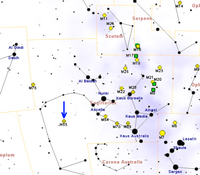Messier 55
Coordinates:  19h 39m 59.40s, −30° 57′ 43.5″
19h 39m 59.40s, −30° 57′ 43.5″
Distance | 17.6 kly (5.4 kpc)[3] | |
|---|---|---|
| Apparent magnitude (V) | 6.3[4] | |
| Apparent dimensions (V) | 19.0′ | |
| Physical characteristics | ||
| Mass | 2.69×105[3] M☉ | |
| Radius | 48 ly[5] | |
| Metallicity | = –1.94 Gyr[6] | |
| Other designations | M55, NGC 6809, GCl 113, C 1936-310[7] | |
Messier 55 (also known as M55, Nicolas Louis de Lacaille in 1752[a] while observing from what today is South Africa.[8] Starting in 1754, Charles Messier made several attempts to find this object from Paris but its low declination meant from there it rises daily very little above the horizon, hampering observation.[b] He observed and catalogued it in 1778. The cluster can be seen with 50 mm binoculars; resolving individual stars needs a medium-sized telescope.[8]
It is about 17,600
dex, whereby −2 would be 100 times less iron than the Sun.[3]
This means the cluster has 1.1% of the proportion of the Sun's iron compared to hydrogen and helium.
Only about 55 variable stars have been found in the central part of M55.[9]
Gallery
See also
- List of Messier objects
References and footnotes
- Bibcode:1927BHarO.849...11S.
- ^ S2CID 119183070
- ^ S2CID 118649860
- ^ "Messier 55". SEDS Messier Catalog. Retrieved April 29, 2022.
- ^ From trigonometry: radius = distance × sin( diameter_angle / 2 ) = 17,600 × sin(19′/2) = 48.6 ly.
- S2CID 3088769
- ^ "M 55". SIMBAD. Centre de données astronomiques de Strasbourg. Retrieved November 16, 2006.
- ^ ISBN 978-0-596-52685-6
- Bibcode:2010AcA....60..245K
- ^ On June 16th
- ^ Specifically in the south of this constellation which makes it visible from everywhere below about the 50th parallel north. However the Sun passes through Sagittarius (or technically the Earth orbits so as to make the Sun seem to do so) throughout December. This also makes the cluster mostly risen during day, not night, in the nearest months.
External links
Wikimedia Commons has media related to Messier 55.
- Messier 55, SEDS Messier pages
- Messier 55, Galactic Globular Clusters Database page
- NASA Astronomy Picture of the Day: M55 Color Magnitude Diagram (23 February 2001)
- Messier 55 on

![{\displaystyle {\begin{smallmatrix}\left[{\ce {Fe}}/{\ce {H}}\right]\end{smallmatrix}}}](https://wikimedia.org/api/rest_v1/media/math/render/svg/4c0821bd80891e071c08e7c7ee8e022baedf522c)


